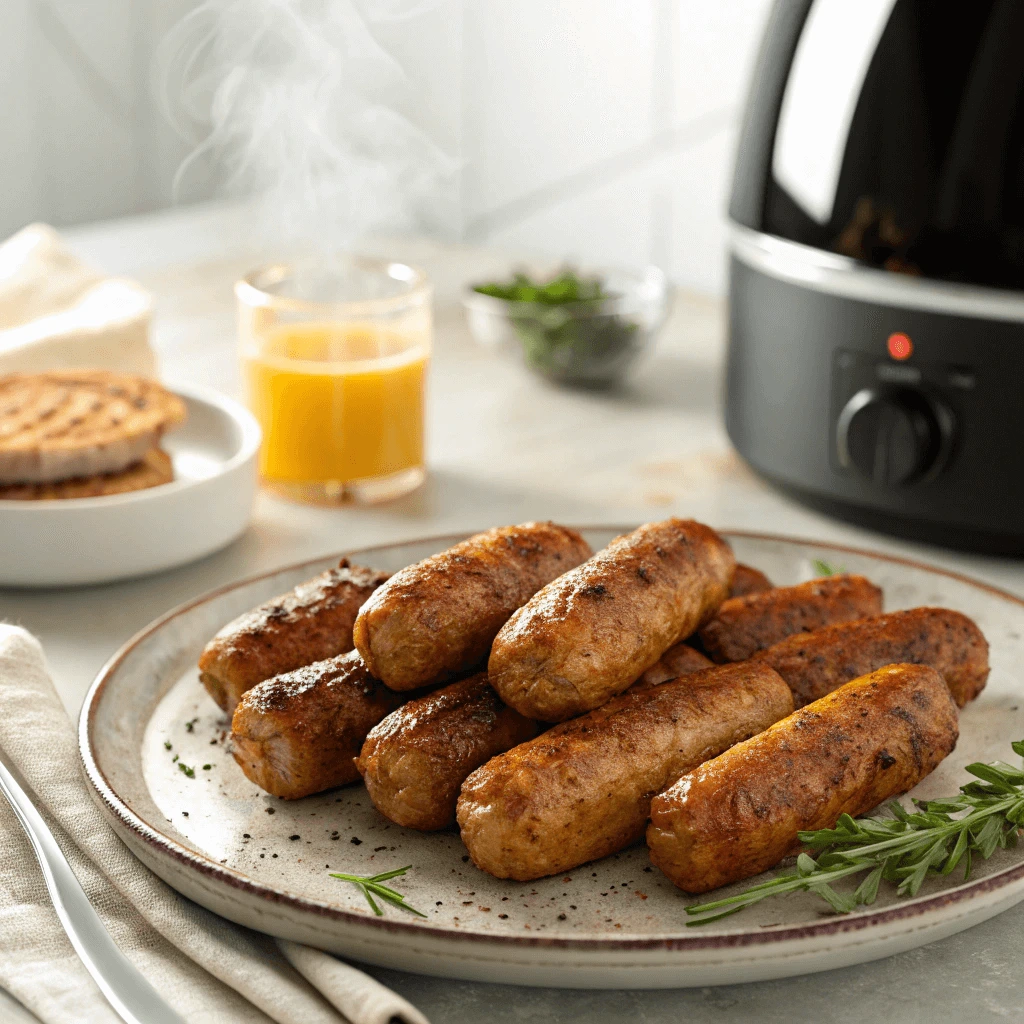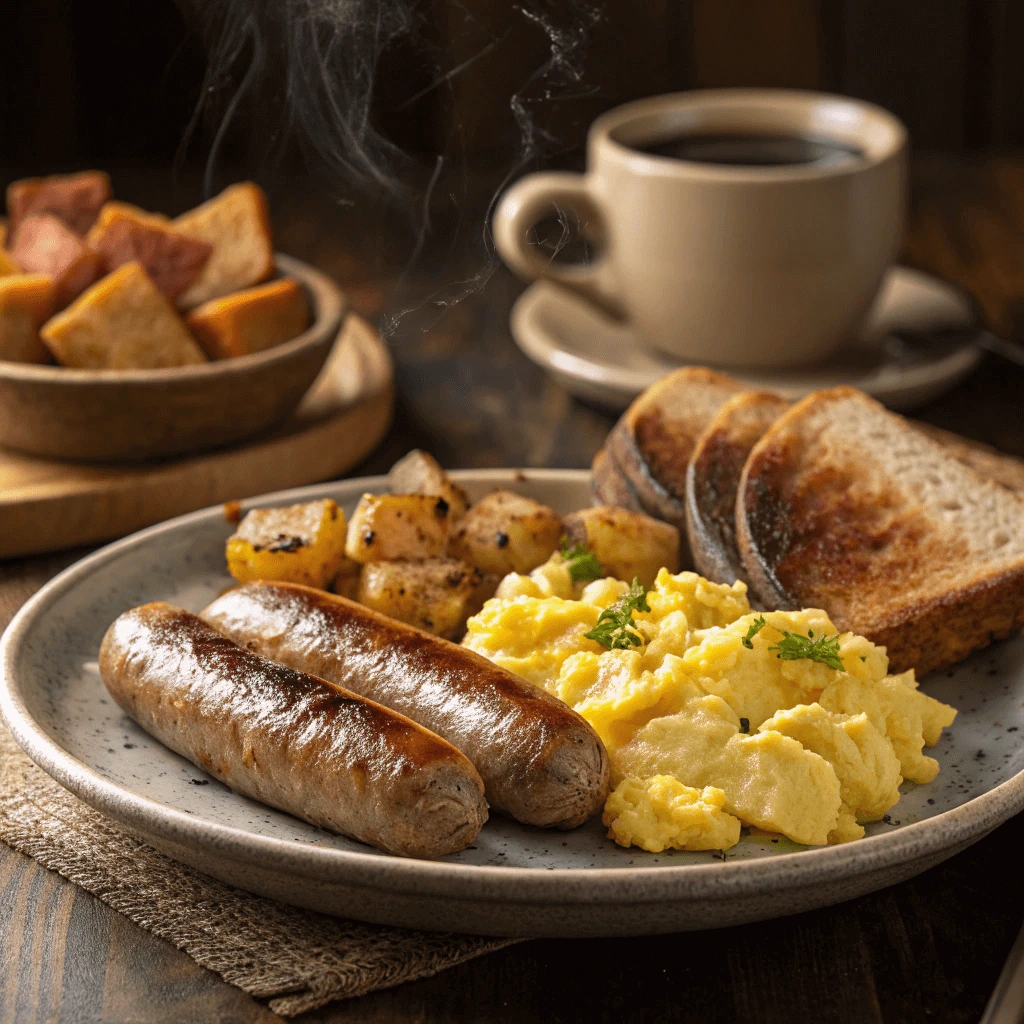Breakfast sausage links are a classic morning favorite, adding savory flavor and satisfying protein to your plate. Whether you prefer turkey, chicken, or plant-based sausage, cooking them to perfection brings out their juicy, crispy goodness. But getting that golden-brown sear on the outside with tender, fully-cooked meat inside requires the right techniques.
In this guide, you’ll discover simple and foolproof methods to cook breakfast sausage links perfectly every time. From stovetop sizzles to crispy air fryer bites and easy oven-baked options, you’ll learn how to achieve delicious results without guesswork. Plus, we’ll share tips to ensure your sausages are cooked safely, evenly, and bursting with flavor.
Ready to master the art of cooking breakfast sausage links? Let’s get started!
Understanding Breakfast Sausage Links

What Are Breakfast Sausage Links?
Breakfast sausage links are small, pre-shaped sausages made specifically for quick and easy cooking. Unlike bulk sausage, which needs to be formed or crumbled, these links come ready to cook, making them a convenient breakfast choice.
Types of Sausage Links
Breakfast sausage links come in several varieties. While traditional sausage links are often pork-based, many people now choose pork-free options like turkey, chicken, or plant-based links. These alternatives offer leaner, healthier choices without sacrificing flavor.
Typical Flavors and Seasonings
Sausage links usually contain a mix of spices and herbs, such as sage, black pepper, and fennel, which give them their distinctive savory taste. Some varieties include a hint of sweetness, balancing the overall flavor.
Why Choose Sausage Links?
Sausage links cook evenly because of their shape and size. They’re easy to portion and pair well with eggs, toast, or hash browns. Their convenient size and great taste make them a breakfast staple for many.
Popular Sausage Link Varieties and Flavors
If you avoid pork, don’t worry — you have many tasty sausage link options for breakfast. These alternatives come in different flavors and textures to suit your taste.
Turkey Sausage Links
Turkey sausage links are a popular pork-free choice. They are lean and flavorful, often seasoned with herbs like sage, black pepper, and garlic. These links stay juicy when cooked right.
Chicken Sausage Links
Chicken sausage links offer a lighter option with bold seasonings like fennel or chili flakes. Proper cooking keeps them moist and delicious.
Plant-Based Sausage Links
Plant-based sausage links use ingredients like soy or pea protein. They mimic the texture and taste of meat sausages, often flavored with spices like paprika and sage.
Flavor Options
Sausage links range from mild to spicy, with some featuring sweet notes like maple or brown sugar to balance the flavors.
Choosing the Right Sausage Links for Your Breakfast
Picking the right sausage links sets the tone for your meal. Here are some key factors to consider.
Match Your Dietary Needs
Choose turkey, chicken, or plant-based sausage links if you avoid pork. Each offers different flavors and textures to suit your preferences.
Look at Ingredients and Flavors
Check the seasonings like sage, black pepper, or fennel. Some links have a sweet touch, such as maple or brown sugar, to balance the taste.
Consider Cooking Style and Size
Thinner links cook quickly on the stove, while thicker ones work well baked in the oven. Pick a size and cooking method that fits your schedule.
Preparing Sausage Links for Cooking

Thawing and Handling Sausage Links Safely
Proper thawing and handling of sausage links help ensure food safety and maintain flavor. Follow these guidelines to prepare your sausage links the right way.
Safe Thawing Methods
Thaw sausage links in the refrigerator whenever possible. Place them on a plate or shallow dish to catch any drips. This slow thaw keeps the meat at a safe temperature and prevents bacteria growth.
If you’re short on time, use the microwave’s defrost setting. Defrost sausage links in short intervals, checking frequently to avoid cooking the edges. Alternatively, you can thaw sausage links by sealing them in a plastic bag and submerging them in cold water. Change the water every 30 minutes to keep it cold.
Avoid Leaving Sausage Links at Room Temperature
Never leave sausage links out on the counter to thaw or sit at room temperature for extended periods. This practice allows harmful bacteria to multiply, increasing the risk of foodborne illness.
Proper Handling to Prevent Cross-Contamination
Always wash your hands before and after handling raw sausage links. Use separate cutting boards and utensils for raw meat and other foods. Clean all surfaces and tools thoroughly with hot, soapy water after use.
Storing Sausage Links Before and After Cooking
Keep raw sausage links refrigerated at or below 40°F (4°C) until you are ready to cook them. Cooked sausage links should be refrigerated within two hours of cooking and eaten within 3-4 days for best quality and safety.
Seasoning and Enhancing Flavor Before Cooking
Even though many sausage links come pre-seasoned, adding extra flavor before cooking can elevate your breakfast experience. Here’s how you can enhance their taste easily.
Assess the Existing Seasonings
First, taste the sausage links raw or check the packaging to understand their flavor profile. Most pork-free sausages use herbs like sage, thyme, or fennel and spices like black pepper or paprika. Knowing this helps you decide what additional seasonings might complement or overpower the links.
Simple Seasoning Boosts
If the links taste mild, sprinkle a little extra seasoning before cooking. A pinch of smoked paprika, garlic powder, or crushed red pepper flakes can add depth and a slight kick. For sweeter notes, try a dash of maple syrup or honey on the links before cooking to create a subtle glaze.
Marinating for More Flavor
You can also marinate sausage links for 15-30 minutes before cooking. Use a mix of olive oil, minced garlic, fresh herbs, and a splash of lemon juice or apple cider vinegar. The marinade adds moisture and infuses fresh flavors into the meat or plant-based links.
Avoid Over-Seasoning
Remember, sausage links already contain spices, so avoid overwhelming them with too many extras. Taste as you go and adjust seasoning gradually.
Experiment with Fresh Herbs and Toppings
After cooking, garnish your sausage links with fresh herbs like parsley or chives. These add a fresh, bright flavor that contrasts nicely with the savory sausage.
Tools and Equipment Needed
Choosing the right tools and equipment plays a key role in cooking breakfast sausage links perfectly. Different methods require specific cookware to get the best flavor and texture.
Cast Iron Skillet for Even Cooking
A cast iron skillet offers excellent heat retention and distribution, making it a favorite for cooking sausage links. It creates a nice sear and crispy exterior while locking in juices. Before cooking, preheat the skillet over medium heat and lightly oil it to prevent sticking. Cast iron skillets also handle high heat well, which is perfect if you want to brown your sausage links evenly.
Non-Stick Pan for Easy Cleanup
If you prefer less maintenance, a non-stick pan is a convenient choice. It requires less oil, which makes your breakfast lighter, and it helps prevent sausage links from sticking or breaking apart during cooking. Non-stick pans heat up quickly, so watch your cooking temperature to avoid burning.
Oven for Hands-Off Cooking
Baking sausage links in the oven offers a hands-off, convenient way to cook multiple links evenly. Use a rimmed baking sheet or an oven-safe pan, lined with parchment paper or foil for easy cleanup. Preheat your oven to around 375°F (190°C), arrange the sausage links evenly, and bake for 20-25 minutes, flipping halfway through. This method reduces the need for constant attention while cooking.
Additional Tools to Have on Hand
Keep a pair of tongs nearby to turn sausage links safely without piercing the meat and losing juices. A meat thermometer helps ensure your sausage reaches the proper internal temperature for safety and juiciness (typically 165°F or 74°C for poultry and plant-based links). Lastly, a spatula or slotted spoon can help transfer cooked links from pan to plate neatly.
Cooking Methods for Perfect Sausage Links

How to Pan-Fry Turkey or Chicken Sausage Links for Juicy Results
Pan-frying turkey or chicken sausage links is a straightforward way to get juicy, flavorful results. Follow these steps to cook them perfectly every time.
Prepare Your Sausage Links
Start by removing the sausage links from the refrigerator and letting them sit at room temperature for about 10 minutes. This step helps them cook more evenly. Avoid thawing frozen sausage links on the counter; instead, use safe thawing methods.
Preheat Your Pan
Choose a non-stick or cast iron skillet for best results. Heat the pan over medium heat and add a small amount of oil, such as olive oil or avocado oil. Allow the oil to warm up but avoid smoking it.
Cook the Sausage Links
Place the sausage links in the pan without crowding them. Cook them for about 10 to 12 minutes, turning every 2 to 3 minutes to ensure even browning. Use tongs to turn the links gently to keep them intact.
Monitor Temperature for Juiciness
Check the internal temperature with a meat thermometer. Turkey and chicken sausage links should reach 165°F (74°C) to be safe to eat. Avoid overcooking to prevent dryness. Once the links reach this temperature, remove them from the pan promptly.
Rest Before Serving
Let the sausage links rest for a few minutes before serving. This allows the juices to redistribute inside the meat, ensuring a juicy bite every time.
Oven-Baking Sausage Links: A Hands-Off Approach
Oven-baking sausage links offers a convenient, hands-off way to prepare them while ensuring even cooking and delicious flavor. Here’s how to get the best results with this method.
Preparing Your Sausage Links for Baking
Begin by preheating your oven to 375°F (190°C). Arrange your sausage links on a rimmed baking sheet lined with parchment paper or aluminum foil. This setup makes cleanup easier and prevents sticking. Space the links evenly so hot air can circulate around each piece, helping them cook uniformly.
Baking Time and Temperature
Place the baking sheet in the oven and bake the sausage links for about 20 to 25 minutes. About halfway through the cooking time, flip the links using tongs. This step helps both sides brown evenly and develop a crispy exterior. Avoid overcrowding the pan to prevent steaming instead of baking.
Monitoring for Perfect Doneness
Use a meat thermometer to check the internal temperature of the links. Poultry-based sausage links should reach 165°F (74°C) for safe consumption. Remove the links promptly when they hit this temperature to avoid drying out.
Benefits of Oven-Baking
Oven-baking requires minimal attention, freeing you up to prepare other breakfast items or relax. This method also produces evenly cooked, juicy sausage links with a nicely browned surface, without the need for constant turning or stirring.
Serving and Storage Tips
Let the sausage links rest for a few minutes after baking to retain their juices. Store leftovers in an airtight container in the refrigerator and consume within 3-4 days for best freshness.
Alternative Methods: Grilling and Air Frying
If you want to switch up your cooking routine, grilling and air frying sausage links offer tasty and efficient alternatives. Both methods bring unique flavors and textures while cooking sausage links evenly.
Grilling Sausage Links for a Smoky Flavor
Grilling adds a delicious smoky char to sausage links that stovetop cooking can’t match. Preheat your grill to medium heat and oil the grates to prevent sticking. Place the sausage links directly on the grill and cook for about 10 to 12 minutes, turning them every few minutes to ensure even browning. Keep a close eye on the links to avoid flare-ups and burning. Grilling also allows excess fat to drip away, resulting in a slightly leaner sausage.
Air Frying for Quick and Crispy Results
Air frying sausage links provides a fast and convenient way to cook them with less oil. Preheat your air fryer to 375°F (190°C). Arrange the links in a single layer inside the basket, leaving space between each to allow hot air circulation. Cook for 10 to 15 minutes, shaking the basket or turning the links halfway through. The air fryer crisps the exterior nicely while keeping the inside juicy.
Benefits and Tips for Both Methods
Both grilling and air frying reduce the need for added fats and offer healthier cooking options. Remember to check the internal temperature of the sausage links with a meat thermometer, aiming for 165°F (74°C) to ensure safety. Rest the links for a few minutes after cooking to let juices redistribute.
Tips for Achieving the Perfect Texture and Flavor
How to Check Doneness with a Cooking Thermometer
Using a cooking thermometer is the most reliable way to ensure your sausage links are cooked safely and perfectly. It helps you avoid undercooking or overcooking while maintaining juiciness.
Choosing the Right Thermometer
Select a digital instant-read thermometer for quick and accurate temperature readings. These devices give fast results and are easy to use, making them ideal for sausage links. Avoid dial thermometers, which may take longer and be less precise.
Proper Thermometer Use
Insert the thermometer into the thickest part of the sausage link without touching the cooking surface or pan. This ensures you measure the internal temperature of the meat accurately. Hold the thermometer steady until the reading stabilizes.
Target Temperature for Sausage Links
For turkey or chicken sausage links, aim for an internal temperature of 165°F (74°C). This temperature guarantees the sausage is safe to eat while staying juicy. Plant-based sausage links usually come pre-cooked, but check the packaging for specific temperature recommendations.
Checking Multiple Links
If you cook several sausage links at once, check the temperature of a few randomly selected links. This ensures that all links reach the proper temperature, especially if sizes vary.
Cleaning Your Thermometer
After each use, clean the thermometer probe with hot, soapy water or a disinfecting wipe. Proper cleaning prevents cross-contamination and keeps your tool hygienic.
Avoiding Common Mistakes When Cooking Sausage Links
Cooking sausage links seems simple, but several common mistakes can affect their taste, texture, and safety. Learn how to avoid these pitfalls for the best breakfast results.
Mistake 1: Cooking Sausages Straight from the Freezer
Many people cook sausage links directly from frozen. This approach leads to uneven cooking—outer parts may overcook while the inside stays raw. Instead, thaw sausage links safely in the refrigerator or use quick thawing methods like cold water or microwave defrosting to ensure even cooking.
Mistake 2: Using Too High Heat
High heat might seem like a way to speed up cooking, but it often causes sausage links to burn outside while remaining undercooked inside. Cook your sausage links over medium or medium-low heat to achieve a golden-brown crust and juicy interior.
Mistake 3: Piercing the Sausage Links
Avoid piercing sausage links with forks or sharp utensils while cooking. Puncturing the casing causes juices to escape, resulting in dry, less flavorful sausages. Use tongs to turn the links gently and preserve their juiciness.
Mistake 4: Skipping Temperature Checks
Relying on appearance alone can be misleading. Use a meat thermometer to check that the internal temperature reaches 165°F (74°C) for poultry sausages. This ensures your sausage links are fully cooked and safe to eat.
Mistake 5: Overcrowding the Pan or Oven
Crowding sausages prevents proper air circulation and heat distribution, which leads to steaming rather than browning. Leave enough space between sausage links when cooking in a pan or oven to allow even cooking and crisping.
Serving Suggestions: What to Pair with Sausage Links
Sausage links make a versatile breakfast ingredient, and pairing them thoughtfully can elevate your meal. Here are some delicious options to complement your sausage links perfectly.
Classic Breakfast Sides
Start with traditional breakfast favorites like scrambled eggs, fluffy pancakes, or buttery toast. The savory, juicy sausage links balance well with these mild, comforting dishes. Adding a side of fresh fruit like berries or melon can brighten the plate with natural sweetness.
Veggie-Packed Options
Incorporate vegetables to add color, texture, and nutrition. Sautéed bell peppers and onions, roasted asparagus, or a simple spinach salad provide a fresh contrast to the rich sausage. Roasted sweet potatoes or hash browns also offer a satisfying, hearty pairing.
Bread and Grains
Whole grain toast, English muffins, or warm biscuits complement sausage links and help soak up flavorful juices. For a more substantial meal, serve with cooked quinoa, brown rice, or a grain bowl topped with fresh herbs.
Sauces and Condiments
Enhance your sausage links with flavorful sauces like mustard, spicy ketchup, or a tangy chutney. Maple syrup or honey works surprisingly well for a sweet-savory combination. You can also try a dollop of creamy avocado or a homemade salsa for added freshness.
Beverage Pairings
Pair your sausage links with a hot cup of coffee, fresh orange juice, or a light herbal tea to round out your breakfast. These beverages refresh the palate and complement the savory flavors.
Delicious Pork-Free Sausage Links Recipes and Breakfast Ideas
Classic Turkey Sausage Links with Eggs and Toast
This timeless breakfast combination pairs juicy turkey sausage links with perfectly cooked eggs and crispy toast. It delivers a balanced, satisfying meal that’s easy to prepare any morning.
Cooking the Turkey Sausage Links
Begin by heating a non-stick skillet over medium heat. Add a small amount of oil or cooking spray to prevent sticking. Place the turkey sausage links in the skillet and cook them for about 10-12 minutes, turning every few minutes to brown all sides evenly. Use a meat thermometer to check that they reach an internal temperature of 165°F (74°C). Once done, transfer them to a plate and let them rest for a few minutes to retain their juices.
Preparing the Eggs
While the sausage cooks, prepare your eggs to your liking. Whether you prefer scrambled, fried, or poached, aim for a tender texture that complements the sausage. For scrambled eggs, whisk eggs with a pinch of salt and pepper, then cook gently over medium-low heat, stirring constantly for creamy results. Fried eggs with runny yolks add a rich flavor, while poached eggs bring a delicate touch.
Toasting the Bread
Choose your favorite bread—whole grain, sourdough, or rye work well—and toast it until golden and crispy. Spread with butter or your favorite spread, such as avocado or jam, for added flavor and texture. Toast acts as the perfect base to soak up juices from the sausage and eggs.
Bringing It All Together
Arrange the turkey sausage links, eggs, and toast on a plate for a classic breakfast presentation. Add a side of fresh fruit or a small salad to boost nutrition and freshness. This combination offers protein, healthy fats, and carbohydrates for sustained energy throughout the morning.
Sausage Link Breakfast Sandwiches and Wraps
Sausage link breakfast sandwiches and wraps make a flavorful and convenient meal, perfect for busy mornings or on-the-go eating. By using non-pork sausage links like turkey or chicken, you can enjoy a delicious breakfast that fits your dietary preferences.
Choosing the Right Sausage Links
Start by selecting high-quality turkey, chicken, or plant-based sausage links. These options provide great flavor and texture without pork. Cook the sausage links thoroughly until they reach an internal temperature of 165°F (74°C), ensuring they remain juicy and tasty.
Building a Breakfast Sandwich
Use toasted English muffins, bagels, or whole grain bread as your base. Layer cooked sausage links with your choice of cheese, such as cheddar or Swiss, and add fresh ingredients like sliced tomatoes, spinach, or avocado. Top with a fried or scrambled egg for extra protein and creaminess.
Wrapping It Up: Breakfast Wrap Ideas
For a lighter or handheld option, choose a large whole wheat or spinach tortilla. Spread a thin layer of cream cheese, hummus, or avocado spread for moisture and flavor. Add cooked sausage links, scrambled eggs, and fresh vegetables like bell peppers or baby kale. Roll the tortilla tightly to keep all the ingredients together.
Tips for Enhancing Flavor and Texture
Add a dash of hot sauce or mustard for a spicy kick. Fresh herbs like cilantro or chives brighten the flavors. Toast your sandwich or wrap in a panini press or skillet to melt cheese and create a crispy exterior.
Serving and Storing
Serve your breakfast sandwiches and wraps immediately for the best taste and texture. You can also prepare them ahead of time and store them in the refrigerator for up to 2 days. Reheat gently in a skillet or microwave before eating.
Creative Breakfast Dishes Featuring Pork-Free Sausage Links
Pork-free sausage links offer a versatile base to create delicious and inventive breakfast dishes. Whether you use turkey, chicken, or plant-based sausages, you can build meals that are both flavorful and nutritious.
Sausage and Veggie Breakfast Skillet
Start by sautéing diced bell peppers, onions, and spinach in a skillet over medium heat. Add sliced cooked sausage links and cook everything together until heated through. Crack a few eggs on top and cover the skillet, allowing the eggs to cook to your preferred doneness. This one-pan meal is colorful, hearty, and packed with protein and vegetables.
Sausage and Cheese Breakfast Casserole
Layer cooked sausage links, beaten eggs, shredded cheese, and your favorite chopped vegetables such as mushrooms and tomatoes in a baking dish. Bake at 350°F (175°C) for 30 to 40 minutes until the casserole is set and golden on top. This dish works well for feeding a crowd or prepping meals ahead of time.
Sausage and Sweet Potato Hash
Cube sweet potatoes and cook them in a skillet with a bit of olive oil until tender and slightly crispy. Add sliced sausage links and cook until warmed through. Finish with a sprinkle of fresh herbs and a dash of hot sauce for a flavorful, satisfying breakfast hash.
Sausage Breakfast Tacos
Warm corn or flour tortillas and fill them with sliced sausage links, scrambled eggs, and toppings like avocado, salsa, and cilantro. These tacos offer a fun, handheld breakfast option that’s easy to customize with your favorite flavors.
Benefits of Using Pork-Free Sausage Links
Pork-free sausages often have lower saturated fat and calories compared to traditional pork sausage. They cater to dietary restrictions and preferences while still delivering robust flavors and satisfying textures.
Conclusion
Cooking breakfast sausage links perfectly every time is all about choosing the right type, handling them safely, and using the proper cooking method. Whether you pan-fry, bake, grill, or air fry, maintaining medium heat and checking the internal temperature ensures juicy, flavorful results. Avoid common mistakes like overcooking or piercing the sausages, and pair them with complementary sides for a balanced meal. With these tips, you’ll enjoy delicious, perfectly cooked sausage links every breakfast—no guesswork needed!
